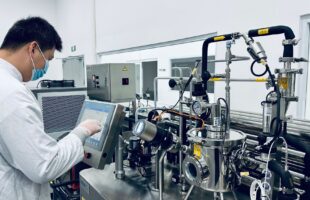
Alternative meat products of today are able to mimic the experience of eating traditional meat. Likemeat/Unsplash
When it comes to innovation and disrupting a traditional industry like food and beverage (F&B), the alternative protein industry is one that has taken center stage in the past few years. Transitioning to other sources of protein, including cultivated meat, is considered a long-term trend with great potential, although the current landscape is still in its nascent stages.
Today, the market is valued at $20 billion and is estimated to reach around $155 billion by 2027. Right now, it comprises 2% of the animal protein market, and will eventually account for 11% of production by 2035, yielding about 97 million metric tonnes.
The U.S. and China are leading markets, with the latter already ⅓ larger, with Singapore and Israel being the forerunners. Asia, in general, is also seen to drive the acceleration of the segment, becoming the largest in the future. It makes sense too as the Asian diet already has a history of substituting meat with other food items like tempeh, tofu and jackfruit.
Both the alternative protein and cultivated meat industries are gaining increasing interest from a research and development, innovation and funding standpoints.
Birthing pains
As these segments are still in the infancy stages, a lot of groundwork still needs to be done in terms of education and awareness. While the opportunities are promising, there are still challenges that hinder the widespread adoption and acceptance of alternative protein.
Alternative protein and cultivated meats are gaining misconceptions because people look at them as processed, therefore unhealthy, or ‘lab-grown’ food. However, recent products are carefully crafted to be low in saturated fat, with little to no cholesterol, and can be tailored to fit certain nutritional needs. Alternative seafood too is free of mercury and harmful microplastics.
In terms of technology challenges, companies need to be constantly improving ingredient formulations so that iterations of the product are delicious and do not compromise on the whole eating experience. Taste and texture have to cater to the different palates in the market in order to entice consumers to consider this compelling alternative.
Modern, cutting-edge technology that is constantly being developed and upgraded will eventually incur a lot of cost. This creates a gap between price points when compared to traditional protein sources, which makes it an expensive product to purchase on a regular basis. Companies may be able to attract those who are curious and may want to try it once, but fail to attract those that need to feed a family or a bigger group of people.
Additionally, local governments and regulatory products are still navigating the space to ensure that products are safe, particularly as novel ingredients are being utilised in GMO products or plant-based food. For smaller spaces like Singapore, facility footprint is also an issue that’s being tackled.
The challenge is to achieve economic efficiency of food processing and production capacity as the industry grows and scales, while meeting all other aspects typically involved in traditional food manufacturing. While there may be a lot of challenges abound, experts are more than optimistic. “We’ve got this new, exciting industry with the new emerging technologies that I think is going to impact the world population for the better,” David Ziskind, Director of Engineering at Black & Veatch – NextGen Ag says.

The sustainability and food security link
In Asia alone, it is estimated that the population will increase to 5 billion by 2050, meaning meat and seafood consumption will rise to 78%, about 10 billion by the same year. And the way the system is working currently is inefficient when it comes to feeding the population. About 9 calories of animal feed produces only 1 calorie of chicken meat, while beef requires 25 to 40 calories.
Resources like water, land and electricity are also at risk of depleting because of climate change, so there is a global pressure to offer more sustainable food that is comparable to what the majority is already used to. Organisations such as the United Nations are getting buy-ins from enterprises across the world to align their own sustainability goals to the worldwide campaigns. This trickles down to the consumer level where buyers are more conscious and aware of how their eating habits affect the environment.
Alternative protein provides a compelling, efficient solution of securing food that’s accessible to all. The broader industry utilises 80% less energy, 90% less water and about 99% land, while the cultured meat sector yields 96% lower GHG emissions. Cultivated meat, in particular, is great for animal welfare as it is created using real meat from cells grown outside the animal.
Countries can localise their protein production and use ingredients that are readily available, which also promotes biodiversity as well. It makes it easier to cater to local tastes and increase adoption, since tastes and flavours are already familiar.
Looking ahead
For Gautam Godhwani, Managing Partner at Good Startup, “We are at the end of the first chapter of alternative proteins, where we have seen innovation in ground meat and plant-based milk.” Coming up is a proliferation of products such as seafood, whole cuts of meat foie gras, and microorganism- and cell-based items. Offerings will soon diversify based on culture and the market will be seeing each region providing specialties. For instance, the U.S. for ground meat, seafood in Asia and non-GMO foods in Europe.
As more players and stakeholders enter the market, production will become more economical and scalable. Alternative and cultivated proteins can only become a staple food item if it is priced affordably, while bringing in profits as well, so innovating, refining and scaling operations using high-volume, low-cost production techniques is vital.
“At the heart of the protein transformation lies the accelerated advancement of technology, and the increase in collaboration between stakeholders throughout the industry,” Ken Chew Tan, Director, Business Consulting, Consumer Packaged Goods & Retail Industry at Dassault Systèmes says. It’s all about different systems in society building partnerships to navigate this relatively unknown space as everyone is learning at the same time.
There needs to be systematic efforts to educate customers from companies, academics and regulatory agencies on what cultivated meat truly is, debunking any common myths that have circulated. Governments must also join to bring information to the forefront and help clear any regulatory pathways.
The market is wide open for food manufacturers to tap into and develop options that can balance taste, nutrition and the overall eating experience. For companies, it’s all about understanding that with innovation comes the flexibility to pivot when needed to meet the needs of the consumer.
Insights provided by Gautam Godhwani, Managing Partner at Good Startup; Ken Chew Tan, Director, Business Consulting, Consumer Packaged Goods & Retail Industry at Dassault Systèmes; David Ziskind, Director of Engineering at Black & Veatch – NextGen Ag.








